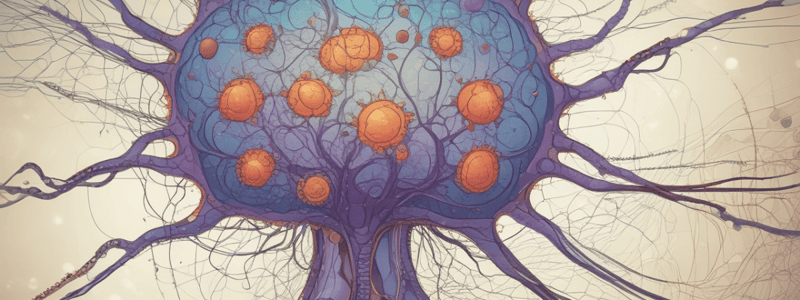Podcast
Questions and Answers
What type of cells help with regulating synapses but do not send signals themselves?
What type of cells help with regulating synapses but do not send signals themselves?
- Ependymal cells
- Oligodendrocytes
- Astrocytes (correct)
- Microglia
Which cells are responsible for the production and movement of cerebrospinal fluid (CSF)?
Which cells are responsible for the production and movement of cerebrospinal fluid (CSF)?
- Microglia
- Oligodendrocytes
- Ependymal cells (correct)
- Astrocytes
What is the main function of Oligodendrocytes in the nervous system?
What is the main function of Oligodendrocytes in the nervous system?
- Myelination of axons (correct)
- Regulating synapses
- Producing CSF
- 'Brain macrophages'
Which type of cells act as 'brain macrophages' to protect the brain from pathogens?
Which type of cells act as 'brain macrophages' to protect the brain from pathogens?
In neurons, which ions have a high concentration outside the membrane at rest?
In neurons, which ions have a high concentration outside the membrane at rest?
What is the primary driving force for ions across the neuronal membrane?
What is the primary driving force for ions across the neuronal membrane?
Which type of channels are always open and responsible for passive movement of ions in neurons?
Which type of channels are always open and responsible for passive movement of ions in neurons?
Which type of ion channels in neurons are triggered by a change in membrane potential?
Which type of ion channels in neurons are triggered by a change in membrane potential?
How many states do sodium voltage-gated ion channels have compared to potassium voltage-gated ion channels?
How many states do sodium voltage-gated ion channels have compared to potassium voltage-gated ion channels?
What is the threshold value that has to be reached to trigger an action potential?
What is the threshold value that has to be reached to trigger an action potential?
Which type of ion enters the cell, making the membrane more positive during depolarization?
Which type of ion enters the cell, making the membrane more positive during depolarization?
What happens to potassium (K+) channels during the repolarization stage?
What happens to potassium (K+) channels during the repolarization stage?
What causes 'overshoot' during an action potential?
What causes 'overshoot' during an action potential?
Which event triggers the opening of potassium (K+) channels during an action potential?
Which event triggers the opening of potassium (K+) channels during an action potential?
When are sodium channels completely inactivated during an action potential?
When are sodium channels completely inactivated during an action potential?
What contributes to making the membrane more negative than usual during hyperpolarization?
What contributes to making the membrane more negative than usual during hyperpolarization?
How is the resting membrane potential restored following an action potential?
How is the resting membrane potential restored following an action potential?
What contributes to contiguous conduction during an action potential?
What contributes to contiguous conduction during an action potential?
Describe the difference in the number of gates between sodium voltage-gated ion channels and potassium voltage-gated ion channels.
Describe the difference in the number of gates between sodium voltage-gated ion channels and potassium voltage-gated ion channels.
What is the significance of reaching the threshold value of -50mV in triggering an action potential?
What is the significance of reaching the threshold value of -50mV in triggering an action potential?
Explain the role of potassium channels during the repolarization stage of an action potential.
Explain the role of potassium channels during the repolarization stage of an action potential.
What causes the 'overshoot' phenomenon during an action potential?
What causes the 'overshoot' phenomenon during an action potential?
Describe the process of resetting sodium channels after an action potential.
Describe the process of resetting sodium channels after an action potential.
Sodium voltage-gated ion channels have both activation and inactivation gates.
Sodium voltage-gated ion channels have both activation and inactivation gates.
Potassium voltage-gated ion channels have two gates - activation and inactivation gates.
Potassium voltage-gated ion channels have two gates - activation and inactivation gates.
During depolarization, potassium ions enter the cell, making the membrane more positive.
During depolarization, potassium ions enter the cell, making the membrane more positive.
The threshold value required to trigger an action potential is +50mV.
The threshold value required to trigger an action potential is +50mV.
During hyperpolarization, the membrane potential becomes less negative than usual.
During hyperpolarization, the membrane potential becomes less negative than usual.
2 forms of refractory periods?
2 forms of refractory periods?
what effects the speed of propagation?
what effects the speed of propagation?
in relative refractory period, AP is possible with larger stimuli
in relative refractory period, AP is possible with larger stimuli
Flashcards are hidden until you start studying




